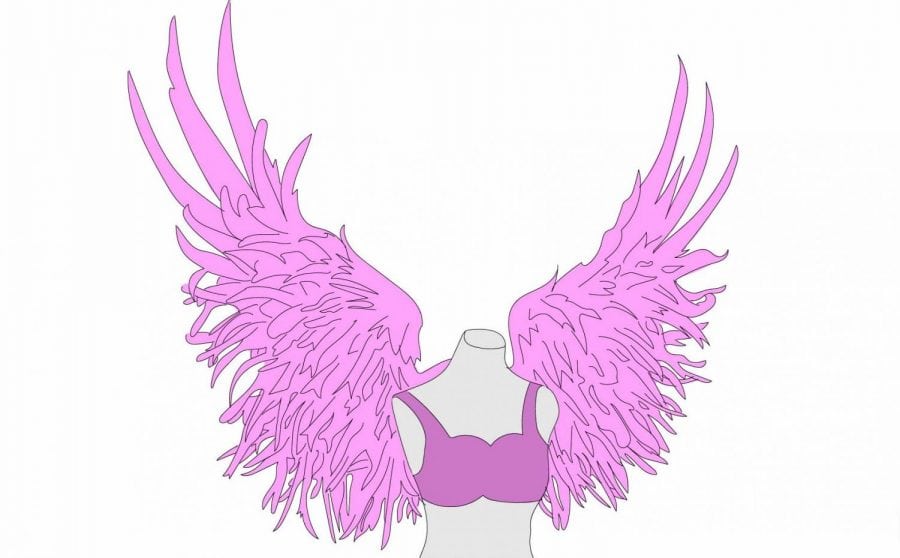Victoria’s Secret is hanging up its infamous wings
July 7, 2021
For over 25 years, Victoria’s Secret has embraced female sexuality with its trendy push-up bras and scandalous teddies. The lingerie tycoon jump-started the careers of some of the most iconic supermodels of all time, including Naomi Campbell, Heidi Klum, Tyra Banks and Gigi Hadid.
Now, Victoria’s Secret has traded in its angel wings and bedazzled “fantasy bras” for the VS Collective.
According to the Victoria’s Secret website, the VS Collective uses “extraordinary partners, with their unique backgrounds, interests and passions” to create revolutionary product collections and rally support for women’s causes.
The new campaign has recruited spokespersons, including actress Priyanka Chopra, professional soccer player Megan Rapinoe and body advocate Paloma Elsesser in an attempt to celebrate realistic body standards.
The news was met with skepticism due to the brand’s controversial marketing strategies over the years and its decision to announce the VS Collective during Pride Month, which the brand has not historically recognized or celebrated.
From failing to issue apologies for cultural appropriation in its fashion shows to ignoring complaints of sexual harassment from female employees on the corporate level, it seems the public’s patience with Victoria’s Secret is running thin.
Up-and-coming lingerie labels like Rihanna’s Savage X Fenty connected with the same women who have felt alienated and undervalued by Victoria’s Secret. This, coupled with the financial hit that the company took last year, has left many people wondering if this rebrand was a calculated, last-ditch effort to save the company.
History of the Fashion Show
In 1977, Roy Raymond, the founder of Victoria’s Secret, felt embarrassed one day trying to buy some “special outfits” for his wife at home. His solution was to create a male-oriented space while using women and lingerie as the commodity, titling it Victoria’s Secret due to its English-inspired boudoir decor.
For generations, the brand, developed by Raymond and other male colleagues like Ed Razek and Les Wexner, stockpiled and outsourced dozens of runway models to create a blueprint of what they deemed the ideal woman.
Victoria’s Secret has come under fire for not only perpetuating an unrealistic standard of beauty, but aggressively directing this harmful message towards young women through their notoriously small sizing system. PINK, another Victoria’s Secret lingerie and apparel line, is geared toward a younger audience.
The company’s first and only “plus-sized” model, Barbara Palvin, walked for the fashion show twice before becoming an Angel in 2019. Palvin is 5-foot-9 and reportedly weighs 120 pounds.
Prior to this, Victoria’s Secret introduced its “Body” lingerie collection in 2014, which seemed like a step in the right direction toward inclusivity.
“Perfect Body” Campaign
The “Perfect Body” campaign followed, which was originally meant to promote the new “Body” lingerie collection at Victoria’s Secret along with a bra that was guaranteed to fit every body type.
There was little variety in the models, all of which were recruited by Ed Razek, the chief marketing officer for L Brands until his resignation in 2019. The campaign’s promotional materials implied that the only desirable body was that of a light-skinned supermodel.
The backlash on social media was overwhelming and, according to ABC News, several petitions in multiple countries demanded that the company “take responsibility for the unhealthy and damaging message that their wording ‘The Perfect “Body’ sends out to society about women’s bodies and how they should be judged.”
A petition circulating in the United Kingdom received 16,000 signatures and generated enough social pressure for the company to change the campaign’s slogan from “The Perfect Body” to “A Body for Everybody.”
Despite the name change, the campaign’s poster still featured the same 10 slim, white or racially ambiguous models as the original poster. Victoria’s Secret never issued a public statement or apology over this controversy.
Kiley Inabnit, a UA sophomore majoring in elementary education and creative media, worked at a Victoria’s Secret retail store for three months. Inabnit said she felt uncomfortable working for a brand that isn’t size-friendly.
“I wear a large, and I could barely fit into their extra-large,” Inabnit said. “I think that [Victoria’s Secret] makes women think that they have to wear expensive and pretty things to impress their men, which is not true.”
Employees and Harassment
Since 1995, Victoria’s Secret annual fashion show has been one of the most anticipated televised events. Publications work tirelessly to bring the Victoria’s Secret Angels to their own magazine covers and fashion campaigns.
Ed Razek, the man behind the fashion shows and the selection of its models, was one of several male executives accused of normalizing the company’s eating-disorder culture through blackmail and sexual harassment.
Razek stepped down from his role in 2019 after he opposing the possible inclusion of transgender models, which hit a sour note with the public. In an interview with Vogue less than a year before his resignation, Razek made his position on expanding the brand’s inclusivity clear.
He said there shouldn’t be any transgender models in the fashion show because the show is meant to be a “fantasy.”
Many employees — all of them women, including several models — have come forward since Razek’s resignation, calling attention to decades of behavior that went unheard and unnoticed. According to the New York Times, Razek harassed runway models, threatening the careers of those who refused to sleep with him.
Casey Crowe Taylor, who worked in Victoria’s Secret’s public relations department for several years, expressed discomfort with the normalization of this behavior in the company’s culture.
“This abuse was just laughed off and accepted as normal. It was almost like brainwashing,” Taylor told The New York Times. “And anyone who tried to do anything about it wasn’t just ignored. They were punished.”
The lack of accountability towards executives didn’t stop at the corporate level. Many former retail employees reported being treated worse than their thinner coworkers.
“The workers were very uptight and thought that they were better than everyone else,” Inabnit said. “I felt very judged for the way I looked.”
Racism and Cultural Appropriation
In addition to complaints about the company’s limited scope of representation and its effects, Victoria’s Secret has come under fire for racism and cultural appropriation.
While the company has presented no interest in representing the average body type, it has also fallen into the habit of casting white or racially ambiguous models.
The “Wild Things” segment of the 2010 Victoria’s Secret Fashion Show featured more women of color than any other part of the show, and nearly all of the models were seen strutting down the catwalk in nothing but loincloths, sarongs, tribal markings, generic animal print bras and animal print wings.
The “Exotic Traveler” and “Nomadic Adventures” segments of the 2014 and 2017 fashion shows faced backlash for repeatedly sending models down the runway in generic Indigenous headpieces, feathers, tribal prints and beaded accessories.
During the “Road Ahead” segment of the 2016 show, Lais Ribero and several other non-Asian models, including Kendall Jenner and Adriana Lima, were seen sporting kimonos, hair chopsticks, fans and other stereotypical Asian garments.
The Verdict
After a troubling history, the public is left wondering if this year’s rebrand will be enough to keep Victoria’s Secret afloat in the face of an ever-changing lingerie market. The company has recruited spokesmodels and ambassadors from all walks of life, but the brand’s previous public statements and lack of accountability left many skeptical.
One Twitter user called the brand’s products “overpriced, exclusionary garbage,” while another said she has felt too large to shop there since middle school.
“I haven’t bought a single VS product since I was in 6th grade. I sized out of their available bra options way back then & never even bothered setting foot in one of their over-the-top stores afterward,” the user said.
Instead of bridging the gap, this rebrand has further alienated three groups: the women who never supported Victoria’s Secret, the women who have abandoned the company, and male consumers.











